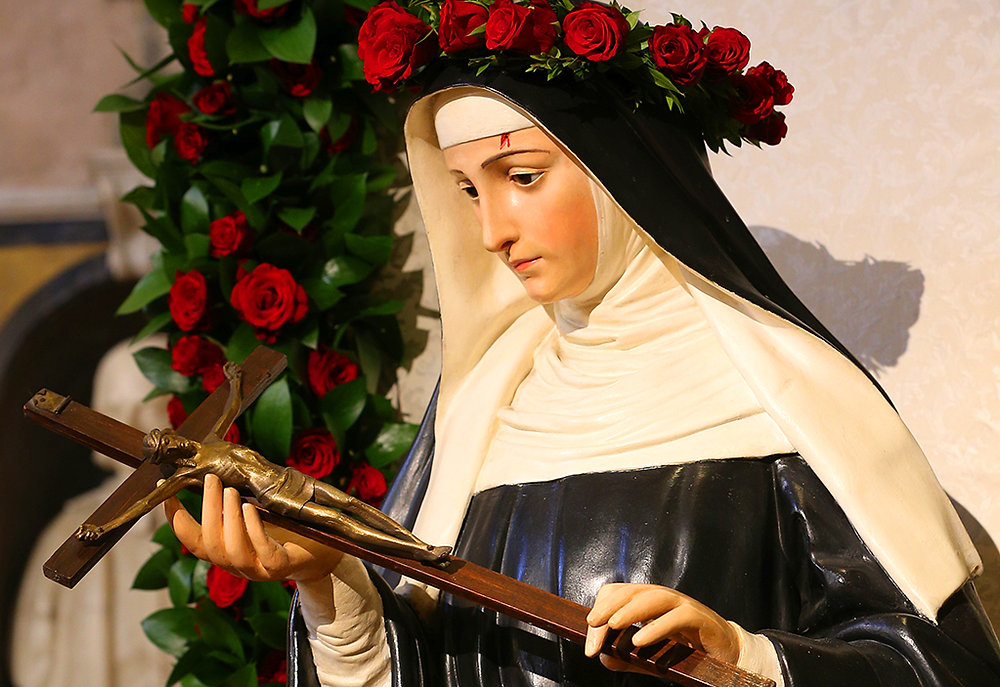Patron Saint of the Impossible, Saint Rita of Cascia

22/05/2023
.
Formações
Today, May 22, the Church celebrates Santa Rita de Cássia, known as the patroness of impossible causes, the protector of widows and the saint of roses. Wife, widow and later a nun, she gives us the example that our state of life is never an obstacle to holiness.
Biography
Born around 1381, Margarida Lotti, affectionately called “Rita”, was of Italian origin, more precisely from Roccaporena, a small town in Umbria. Her parents were pious peasants who, realizing the need, sent her to Cassia, where she received school and religious instruction from the Augustinians.
From a young age, she received the call to religious life, however, her elderly parents promised her in marriage to Paulo Ferdinando de Mancino when she was around 17 years old. The saint did not object and trusted in the judgment of her parents, and faithfully offered herself in marriage. In her family life, she was a devoted wife and a zealous mother, and despite the rudeness with which she was treated by her husband, she always showed piety and a desire to be an apostle at home, not by chance, it is said that Paulo left until Easter. becoming more and more docile.
Later, their children, Giangiacomo Antônio and Paulo Maria, fell ill due to the plague that attacked the region. The saint was consoled by realizing that the souls of her children were spared from revenge for the death of their father, murdered for involvement with political factions.
In the bosom of the family, he had completed his mission. From then on, his first vocation found a favorable occasion. Rita, aged 36, met the Augustinians again, now with a request to become a nun. Despite the difficulties she had with the political disputes in which her husband was involved, her prayers were heard, and the revolts of the families that promoted the death of Paulo de Mancino ceased, the Monastery of Santa Maria Madalena de Cássia received her.
From a young age, she received the call to religious life, however, her elderly parents promised her in marriage to Paulo Ferdinando de Mancino when she was around 17 years old. The saint did not object and trusted in the judgment of her parents, and faithfully offered herself in marriage. In her family life, she was a devoted wife and a zealous mother, and despite the rudeness with which she was treated by her husband, she always showed piety and a desire to be an apostle at home, not by chance, it is said that Paulo left until Easter. becoming more and more docile.
Later, their children, Giangiacomo Antônio and Paulo Maria, fell ill due to the plague that attacked the region. The saint was consoled by realizing that the souls of her children were spared from revenge for the death of their father, murdered for involvement with political factions.
In the bosom of the family, he had completed his mission. From then on, his first vocation found a favorable occasion. Rita, aged 36, met the Augustinians again, now with a request to become a nun. Despite the difficulties she had with the political disputes in which her husband was involved, her prayers were heard, and the revolts of the families that promoted the death of Paulo de Mancino ceased, the Monastery of Santa Maria Madalena de Cássia received her.
Obedience and the Dry Vine
That she was a model of obedience, she had already demonstrated in her marriage, but in her religious life, Santa Rita de Cássia reached fullness. In the monastery, as a nun, she had to behave in accordance with hierarchy and discipline. Following this concept, her superior, in order to make sure that Rita understood that her adherence to the authorities was a service to God himself, who uses even bad leaders to carry out his work, tested her humility: she asked, as a daily duty, that water a dry, lifeless branch, probably from a vine.
Later, their children, Giangiacomo Antônio and Paulo Maria, fell ill due to the plague that attacked the region. The saint was consoled by realizing that the souls of her children were spared from revenge for the death of their father, murdered for involvement with political factions.
In the bosom of the family, he had completed his mission. From then on, his first vocation found a favorable occasion. Rita, aged 36, met the Augustinians again, now with a request to become a nun. Despite the difficulties she had with the political disputes in which her husband was involved, her prayers were heard, and the revolts of the families that promoted the death of Paulo de Mancino ceased, the Monastery of Santa Maria Madalena de Cássia received her.
Later, their children, Giangiacomo Antônio and Paulo Maria, fell ill due to the plague that attacked the region. The saint was consoled by realizing that the souls of her children were spared from revenge for the death of their father, murdered for involvement with political factions.
In the bosom of the family, he had completed his mission. From then on, his first vocation found a favorable occasion. Rita, aged 36, met the Augustinians again, now with a request to become a nun. Despite the difficulties she had with the political disputes in which her husband was involved, her prayers were heard, and the revolts of the families that promoted the death of Paulo de Mancino ceased, the Monastery of Santa Maria Madalena de Cássia received her.
Obedience and the Dry Vine
That she was a model of obedience, she had already demonstrated in her marriage, but in her religious life, Santa Rita de Cássia reached fullness. In the monastery, as a nun, she had to behave in accordance with hierarchy and discipline. Following this concept, her superior, in order to make sure that Rita understood that her adherence to the authorities was a service to God himself, who uses even bad leaders to carry out his work, tested her humility: she asked, as a daily duty, that water a dry, lifeless branch, probably from a vine.
Resolute in austerely complying with the order, however odd it might seem, not a day went by without zealously caring for that branch, hoping to please God by lovingly fulfilling the mission assumed in the monastery. She was the target of mockery, she was put to the test, but she did not stop being obedient.Until the mercy of God operated its mysteries, in a situation that until then had been trivial and unimportant, making it clear that nothing is small if done with love, as St. Theresa used to say.
As time went by, what seemed meaningless and lifeless, responded to the love dedicated by that humble widow, who even had no value before those experienced nuns who did not recognize her sanctity, and the withered stick gained life, leaves began to sprout , surprising all the sisters, who later saw that miracle become a great vine.
In the spiritual life this logic is maintained, let us water our dry branches with the love of obedience, which sooner or later, the great vine of holiness will sprout in us, which will bear fruit for us and for other generations. We never despise or underestimate the commands we receive in our daily lives, they are the ones that lead us to heaven, they are the crumbs of God left as clues to paradise, which without the supernatural look are nothing more than dirt on the ground.
Resolute in austerely complying with the order, however odd it might seem, not a day went by without zealously caring for that branch, hoping to please God by lovingly fulfilling the mission assumed in the monastery. She was the target of mockery, she was put to the test, but she did not stop being obedient.Until the mercy of God operated its mysteries, in a situation that until then had been trivial and unimportant, making it clear that nothing is small if done with love, as St. Theresa used to say.
As time went by, what seemed meaningless and lifeless, responded to the love dedicated by that humble widow, who even had no value before those experienced nuns who did not recognize her sanctity, and the withered stick gained life, leaves began to sprout , surprising all the sisters, who later saw that miracle become a great vine.
In the spiritual life this logic is maintained, let us water our dry branches with the love of obedience, which sooner or later, the great vine of holiness will sprout in us, which will bear fruit for us and for other generations. We never despise or underestimate the commands we receive in our daily lives, they are the ones that lead us to heaven, they are the crumbs of God left as clues to paradise, which without the supernatural look are nothing more than dirt on the ground.
Holy Wound, Holy of the Impossible
The special devotion that the Olhar Misericordioso community has for the wounded saints concerns Santa Rita de Cássia with greater affection and veneration, after all, when asking Jesus to participate in his Passion, she received the wound of the crown of thorns that they placed on Christ on her forehead. , which remained for 15 years.And even in that moment of spiritual blossoming, there is the story of the request made to her cousin in a rigorous winter, on a visiting day at the monastery, when the tree in her father’s house could not bear any fruit due to the season, but still so he asked for 2 figs and a rose from the garden. The cousin, at that moment just out of complacency, did not reply, despite carrying in her conscience the impossibility of such a request. But God, in yet another detail of love for our venerable Rita, allowed another miracle to happen through his faithful daughter. This request by Rita, it was later discovered, was a question she had asked God about the entry of her children and husband into Paradise. Once she received 2 figs for her boys and a rose for her husband, she was deeply comforted by the positive response.
Therefore, God notices our faithfulness. He, being faithful and just, gives us all the Grace we need to one day deserve to reach the eternal home. Santa Rita de Cássia never needed consolation or ease to be faithful in little, and in his goodness, the Creator joyfully receives the children who corroborate for His plans to happen. Let us also be clay in the potter’s hand, let us allow ourselves to be molded like Santa Rita, let us not offer resistance to life’s setbacks, but realize that at all times He gives us opportunities for holiness!
Therefore, God notices our faithfulness. He, being faithful and just, gives us all the Grace we need to one day deserve to reach the eternal home. Santa Rita de Cássia never needed consolation or ease to be faithful in little, and in his goodness, the Creator joyfully receives the children who corroborate for His plans to happen. Let us also be clay in the potter’s hand, let us allow ourselves to be molded like Santa Rita, let us not offer resistance to life’s setbacks, but realize that at all times He gives us opportunities for holiness!
All for Jesus nothing without Mary!









